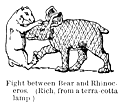Venatiōnes
The contests of beasts with one another, or of men with beasts, that formed part of the
shows of which the Romans were passionately fond. They were first introduced at the games of
Marcus Fulvius Nobilior, B.C. 186 (
Livy, xxxix. 22). Those who
took part in these contests were called
bestiarii. They were either
criminals and prisoners of war, who were poorly armed or completely unarmed, pitted against
wild beasts which had previously been made furious by hunger, branding, and goading; or else
hired fighters who, like gladiators, were trained in special schools and fully armed. Even in
the last century of the Republic, and still more under the Empire, incredible expenses were
incurred in the collection of the
 |
|
Fight between Bear and Rhinoceros. (Rich, from a terra-cotta lamp.)
|
rarest animals from the remotest quarters of the globe and in the other arrangements
for their baiting. Sulla first exhibited lions let loose in the Circus (
De Brev.
Vit. 13); Clodius Pulcher first gave an elephant fight; Scaurus first showed a
hippopotamus and crocodiles in a pond or trench (Pliny ,
Pliny
H. N. viii. 96). Pompey provided a show of 500 lions, 18 elephants,
and 410 other African animals; and Caligula caused 400 bears and the same number of animals
from Africa to tear each other to pieces. When the great amphitheatre of
Titus was dedicated 9000 animals were killed; and at the Dacian celebration of Trajan, 11,000
(
Suet. Tit. 7; Dio Cass. lxviii. 15).
Occasionally at these combats with wild beasts the man condemned to death
 |
|
Venatio. (Pompeian painting.)
|
was attired in an appropriate costume, so as to represent a sanguinary scene from
mythology or history, as, for example, Orpheus being torn to pieces by bears. Down to the end
of the Republic these shows took place in the Circus, and the greater exhibitions were
held there even after that time, until the amphitheatres became the usual places of
performance; and, indeed, when they were combined with the gladiatorial exhibitions, they took
place in the early morning before them. They were continued down to the sixth century. See
Friedländer,
Sittengeschichte Roms, 5th ed. ii. pp. 348 foll.;
Marquardt,
Staatsverwaltung, iii. 565.
Among the Greeks, especially the Athenians, cock-fights and quail-fights were very popular.
At Athens cock-fights were held once a year in the theatres at the public expense. The
training of fighting-cocks was conducted with great care. Certain places, such as Tanagra in
Boeotia, Rhodes, and Delos, had the reputation of producing the largest and strongest. To whet
their eagerness for the combat, they were previously fed with garlic. Their legs were armed
with brass spurs, and they were set opposite to each other on tables furnished with raised
edges. Bets, often to an enormous amount, were laid on the fights by the gamesters as well as
by the spectators.






